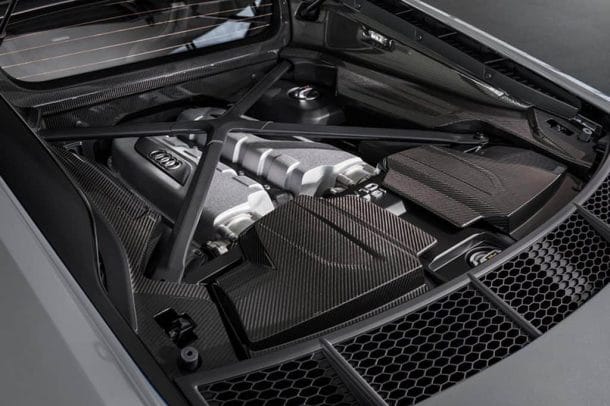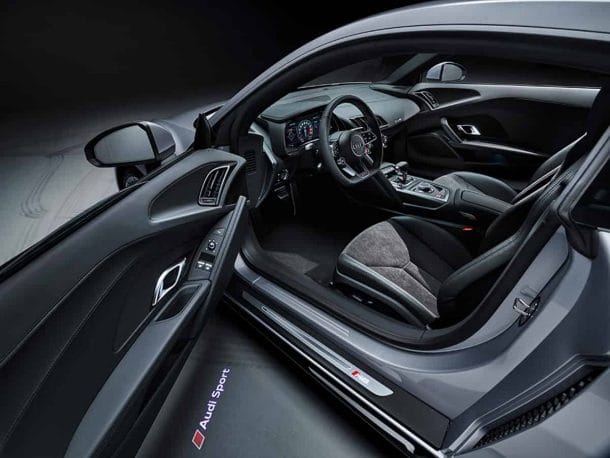No Audi is closer to motor racing than the Audi R8 Coupe V10 performance quattro. Like all the RS models built by Audi Sport, Audi AG’s high-performance division, the R8 Coupe V10 went through over 8,000 kilometers of development work and testing at the demanding Nurburgring track in Germany. The R8 Coupe V10 spearheads the Audi Sport range, and so also headlines the RS lineup in the Philippines, currently composed of the RS3 Sedan, RS Q3 SUV, RS 5 Coupe, RS 5 Sportback, RS 6 Avant and the RS Q8 SUV.
Here are five impressive facts to know about Audi’s thrilling supercar:
1. It is identical to the highly successful racecar version.
“Born on the racetrack, built for the road;” the road-going version of the Audi R8 and the Audi R8 LMS racecar are built alongside one another, and more than half of their parts are identical. The Audi R8 LMS has three versions designed for as many race classes. It boasts of 18 global titles in GT4, and enough GT3 class victories at the 24 Hours of Nurburgring to make Audi Sport the most successful GT3 manufacturer in the legendary motor sports event. This year alone, the Audi R8 LMS GT2 has already clinched two victories in the GT2 championship season-opener in Monza, followed by two more wins at the succeeding Hockenheim round. With components shared with the LMS racecars, the Audi R8 Coupe V10 provides the same performance on the road.

2. It is one of the last supercars with a naturally aspirated engine.
At the heart of the new Audi R8 Coupe V10 is a 5.2-liter FSI V10 engine that is naturally aspirated, ensuring a more linear power delivery, instant acceleration and a purer driving experience. The engine’s uprated 620hp and 580Nm output, accompanied by a sound unique to a non-boosted V10, allows the supercar to sprint from rest to 100 km/h in 3.1 seconds and reach a maximum speed of 331 km/h. The power increase in the latest model comes primarily from an optimized valve train with components made from titanium, resulting in immediate response as the engine freely revs all the way to 8,700 rpm. A seven-speed s-tronic dual clutch transmission sends the power to the quattro permanent all-wheel drive system.
3. It rides on a suspension system derived from motor sports.
The suspension of the Audi R8 Coupe V10 uses racing technologies. Fitted to the supercar are aluminum double wishbones in all four corners, and the Audi magnetic ride—a regulated damping system that continuously adapts the shock absorbers for each wheel according to the road profile and the driver’s style. The changes happen in intervals of milliseconds. Synthetic oil in the pistons of the shock absorbers contain very small magnetic particles that act when electrical current is applied, adjusting the damping rate of the suspension.

4. It has a cockpit completely focused on the driver.
The Audi R8 Coupe V10 offers a seating position similar to LMS racecars. Its operating concept is focused on the driver alone, who can operate all key functions without him having to take his hands off the steering wheel, or look away from the road. The multifunction steering wheel plus integrates buttons for the MMI, ignition, the basic modes of Audi drive select, and the performance programs. The 12.3-inch display of the Audi virtual cockpit shows information from the MMI navigation plus, as well as a performance screen dominated by a large tachometer. Readouts for power output, torque, G-forces, lap times, engine and transmission oil temperatures, and tire pressure and temperature can also be shown here.
5. Its lightweight body structure is designed to raise performance.
Anchoring the Audi R8 Coupé V10’s lightweight design is the Audi Space Frame (ASF), resulting in a body structure that weighs a mere 200 kilograms. Large parts made from carbon fiber-reinforced polymer, such as the rear panel, the center tunnel, and the B-pillars form the ultra-high-strength backbone of the car’s passenger cell, making it extremely stiff. The car’s front and rear body modules, the floor pan of the luggage compartment, and outer skin, doors and lids are all aluminum. With this mix of materials, the ASF achieves high torsional rigidity that helps the car handle more precisely, offer better crash protection, and quell vibrations coming from the engine, chassis and suspension.

